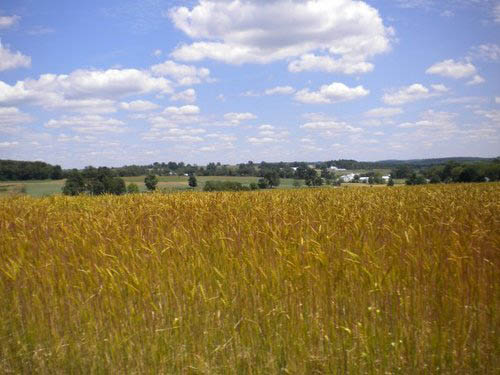
Wyandot and Delaware Indian town-About 1750-1785
In the middle 1750s, perhaps for some time before,
about 100 Delaware Indian persons lived in Shenango Town, an Indian
village in what is now West Middlesex (PA), just south of Sharon. |
Travel was by foot
They traveled by foot and received provisions from
the French who had forts in western Pennsylvania before their defeat by
the British in the French and Indian War. And, from the villages, the
young men set out in bands of warriors, marauding white settlements,
returning with the proof of their victories---scalps and prisoners. |
Smallpox epidemic
Next spring Nicholas and his band moved to the
Muskingum River. Sept. 8., Conrad Weiser, the British agent, held a
council with some of the Wyandots at Logstown. Nicholas himself seems
to have remained at the Muskingam with part of his band. In 1751 there
was a smallpox epidemic in Ohio. In a letter written Aug. 10 of that
year, the French governor of Canada reported that Nicholas was dead. |
Life in Shenango Town
One of the best sources quoted by Hunter for an
account of Shenango Town was written by John McCullough, captured at
the age of 8 in Franklin County and adopted by a family of Delaware
Indians with whom he lived eight years, the first two at Shenango Town.
McCullough's recollections gave a vivid picture of life in Shenango
Town and are reprinted elsewhere in this edition. |
Town abandoned
From later information, it is clear that Shenango
Town was only temporarily abandoned in 1758, though it possibly was a
smaller town thereafter. |

Pontiac's War
The period of relative quiet in western
Pennsylvania which began in 1758, ended suddenly in 1763 with Pontiac's
War, when the Indians, disturbed by the loss of their French allies,
made a desperate attempt to prevent British occupation of the Ohio
lands.
|
Moravian mission
From 1770 to 1773, the Moravia Church,
headquartered at Bethlehem, PA, maintained an Indian mission just north
of the present town of Moravia which was just south of New Castle. The
Delaware Indian name of the mission was Languntoutenink or, in German
(the Moravians were German-speaking), Friedensstadt (City of Peace). |
Indian chief
Hunter also found two other listings about this Indian chief in the diary of the Moravian mission at Schonbrunn in Ohio. |
Relatives lived apart
"Unfortunately," said Hunter, "there doesn't seem
to be anything more about Simon's brother. The incident illustrates the
fact that Indians, like other people, had relatives in different
places. Simon had lived at Shenango, but his brother was from Kuskusky." |
Path to Pymatuning
"The left hand path goes about three miles to
Pymatuning Town, on the same creek. After crossing this creek, the path
goes through level land, well timbered, eight miles, to the same creek
again, eight yards wide, here is a good ford and a number of Indian
graves." |
Delaware, Wyandot land
By the Treaty of Fort Stanwix Oct. 23, 1784, the
United States bought from the Iroquois all of Northwestern
Pennsylvania, except the Erie Triangle. By the Treaty of Fort McIntosh
(Beaver) Jan. 21, 1785, the government bought the Delaware and Wyandot
claims to the same territory. |
Linger at Shenango
A few Indians lingered at, or near, Shenango Town.
John Adlum, on a map of about 1791, showing the newly-run state
boundaries, noted that "There is an Indian town on or near the Shenango
branch of the big Beaver Creek about 30 or 35 miles from Fort Franklin.
It contains about 12 or 15 families, some of whom a certain John Ray
informed me were Delawares." |
|
|
||
|
|
||
|
|
||